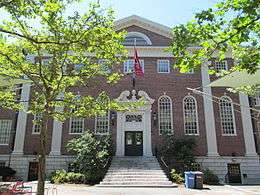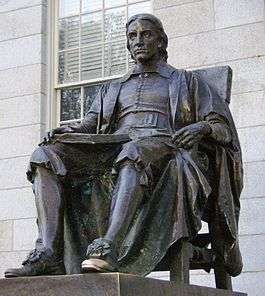Lehman Hall (Harvard University)

Lehman Hall is a Georgian-revival building by Charles Coolidge[1] completed in 1925[2] as part of Harvard President Abbott Lawrence Lowell's program to "cloister" Harvard Yard.[1] Named for donor Arthur Lehman (1873–1936) and his wife Adele,[3] its exterior "is a modified example of the early New England counting house."[4] It is the home of Dudley House, the only one of Harvard's thirteen undergraduate "houses" serving nonresident students.
Description
Lehman Hall occupies the site on which the second, third, and fourth meetinghouses (1650, 1706, 1752) of The First Parish in Cambridge had been built. The site became Harvard property in 1833.[5]
In keeping with its original function as the home of Harvard's Bursar's Office – for part of which time it was known as "The Counting House"[6] – its "heroic parade of pilasters, a bit overblown admittedly, [are] doubtless intended to mark the principal frontispiece, as Lehman is, of Yard to [Harvard] Square" (as Shand-Tucci put it).[7] Its "main chamber reaches practically the entire height of the building, is finished in delicately modeled cream plaster ... an extraordinarily light, cheerily simple room. A balcony reaches about part of its upper circumference."[4] Bainbridge Bunting wrote that its "public function is announced by an architectural frontispiece of giant pilasters and arched windows repeated on both major elevations. The building's mass also is sufficient to announce its official role and to define the triangular open space on its east side, although the pilasters are out of scale with other buildings in the Yard." The plaza immediately in front of its Yard-facing elevation once had a sculpture by Henry Moore.[1]
Dudley House
In 1965 Lehman Hall assumed its current function[8] as home of one of the thirteen undergraduate "houses" within Harvard College, Dudley House, which serves the very few Harvard undergraduates not living in one of the other twelve (residential) houses (that is, students living in off-campus apartments and in the student-run Dudley Coop).[9][10]
It also provides certain services to the University's graduate students.
References
- 1 2 3 Bainbridge Bunting (1998). Harvard: An Architectural History. Bellknapp Press. ISBN 978-0674372917.
- ↑ "Many New Sights Greet Alumni Around Square | News | The Harvard Crimson". Thecrimson.com. 1925-11-21. Retrieved 2015-08-12.
- ↑ John T. Bethell (1998). Harvard Observed. Harvard University Press. p. 100–1. ISBN 978-0674377332.
- 1 2 "A Touch of the Old, More of the New – A Changed Harvard and Square Greet Students". Christian Science Monitor. September 25, 1925. p. 1.
- ↑ "Harvard University. Corporation. Records of early Harvard buildings, 1710-1969: an inventory". Oasis.lib.harvard.edu. Retrieved 2015-08-12.
- ↑ "Workmen Begin On New Administration Building | News | The Harvard Crimson". Thecrimson.com. 1924-10-08. Retrieved 2015-08-12.
- ↑ Douglas Shand-Tucci (2001). The Campus Guide: Harvard University. Princeton Architectural Press. ISBN 978-1568982809.
- ↑ Greenhouse, Linda J. (1965-05-06). "Dudley House Finds Home; Will Move to Lehman Hall | News | The Harvard Crimson". Thecrimson.com. Retrieved 2015-08-12.
- ↑ "Main § Dudley House". Fas.harvard.edu. Retrieved 2011-10-18.
- ↑ Comstock, Craig K. (1959-05-07). "Still Needed: 'Real House' for Non-Residents | News | The Harvard Crimson". Thecrimson.com. Retrieved 2015-08-12.
